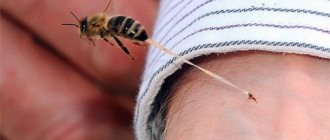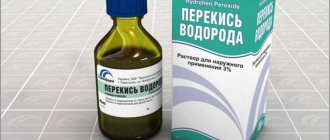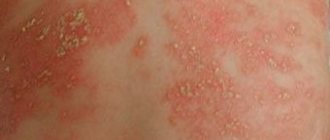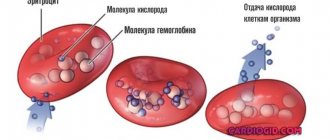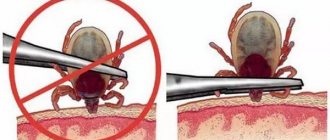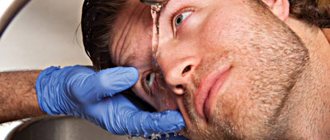Why are bee or wasp stings dangerous?
Among all hymenoptera insects, there are several species that most often sting people. This:
- bees;
- wasps;
- hornets;
- bumblebees.
Moreover, the first two have the dubious “honor” of being leaders in aggressive actions.
The danger of bites from these insects is somewhat exaggerated. Most people who are stung face no risk other than some discomfort. At the very moment of the sting, a sharp pain and burning sensation occurs at the site of the sting, which passes over time. Swelling immediately develops, and the more pronounced it is, the more fat or loose fiber there is under the wound. Redness after a bee or wasp sting is common.
The presence of fiber under the skin is an important factor influencing the general condition of a person after a sting. Danger arises from situations where the sting has stuck into the lip area, soft or hard palate, or tongue. In this case, a pronounced local reaction occurs in the form of severe swelling, which can block the upper respiratory tract, and the person will simply suffocate.
In general, the venom of wasps and bees is harmless. For it to kill a healthy person, it must be stung by several hundred insects. Even the stings of a dozen bees will only cause a general reaction in the form of a rise in temperature (more often in a child), chills, and weakness.
Allergic reactions to the venom of Hymenoptera (this group of insects includes wasps and bees) are much more dangerous. In this case, upon first contact with the poison, sensitization occurs, that is, a failure of the immune response. The second contact triggers a chain of pathological reactions, as a result of which an allergy develops.
Localized urticaria is considered the least dangerous - the appearance within a few minutes of skin itching, a spotted red rash on certain parts of the body (the spots merge, forming unevenly shaped reddened “fields”), and weakness, usually unexpressed, may occur. Swelling at the site of the bite is no different from swelling in the absence of allergies. When the rash spreads to the entire body, it is referred to as generalized urticaria - a more severe condition that is not yet life-threatening, but can become a harbinger of severe complications.
One of these severe conditions is Quincke's edema. In this case, the soft tissues of the face - lips, eyelids, cheeks - swell first. The transition of swelling to the neck is dangerous for the development of laryngeal edema - a deadly condition in which the upper respiratory tract is completely blocked. Death occurs within a few minutes from suffocation.
An even more dangerous, although rare, complication of a bee or wasp sting is anaphylactic shock. In this case, within a few minutes the patient’s blood pressure drops sharply, the pulse quickens, and the rash spreads throughout the body. The skin becomes pale and cold, sticky sweat appears. The outcome of anaphylactic shock is death from acute cardiovascular failure. But this is only if the patient is not helped.
General information
Wasps are insects that can be found in different places - both in villages and cities.
There are several varieties of these insects. However, the reaction to their bite is the same: it is very painful and unpleasant, since the venom of all types of wasps acts in a similar way. The ICD-10 code is W57 (bite or stinging by non-venomous insects and other non-venomous arthropods). But in some cases, a wasp or hornet is a particularly dangerous insect. After all, when talking about how dangerous a wasp sting is for a person, it should be taken into account that it can provoke a very acute allergic reaction . Therefore, it is most dangerous for those who are prone to allergies . Multiple bites are especially dangerous. Therefore, it is very important to know how to act correctly if a person is bitten by an insect, and what to do if an allergic reaction occurs. This will be discussed in the article.
Wasp or bee sting: what to do at home
If you are stung by a bee, the first step is to remove the sting. For this purpose, use tweezers or a sterile needle (you can calcinate a regular sewing needle over a fire). The bite site is treated with any antiseptic, and ice is applied to reduce the absorption of the poison into the narrowed blood vessels. Some mothers are interested in how to relieve swelling in a child after a wasp sting. Ice will help reduce its severity.
It is advisable to apply any hormonal ointment locally - hydrocortisone, prednisolone. If the victim is prone to allergies or the sting occurs in a dangerous place (oral cavity, neck, face), he needs to take a tablet of one of the antihistamines - Tavegil, Suprastin. Loratadine and cetirizine are not very suitable due to their rather slow onset effect.
Severe allergies require administration of medications in the form of injections. Most often, this is available only to specialists who administer adrenaline, prednisolone and suprastin intramuscularly, and in critical cases, intravenously. In case of anaphylactic shock, drip infusions of various solutions may be required, without which it is impossible to raise the decreased blood pressure. In addition, the victim is placed on his back, with his legs raised above head level. In case of vomiting and loss of consciousness, the patient is placed on his side.
For angioedema, accompanied by swelling of the larynx, a mini-surgery may be required, which can only be performed by a qualified doctor. In this case, the soft tissues of the neck are cut in a certain place so as to open the lumen of the larynx. A tube is inserted into it through which the victim will breathe. This operation is called cricoconicotomy and sometimes it is the only way to save a person’s life.
A wasp or bee sting is usually not dangerous, however, it always requires attention. No one knows how the human body will react to this type of injury. Therefore, at the slightest sign of trouble in the body, you should immediately call an ambulance and follow all the recommendations of doctors.
Pathogenesis
The venom of Hymenoptera insects contains non-allergenic amines and peptides. They determine the appearance of local reactions to the bite, provoking the inflammatory process and affecting the blood vessels. In addition, the venom contains allergenic proteins (in particular antigen-5), under the influence of which antibodies . If we talk about wasp venom in more detail, it contains the following components:
- Histamine – provokes the development of an allergic reaction (redness, itching, swelling of the skin).
- Phospholipases - destroy blood cells and tissues, stimulating the manifestations of allergies.
- Acetylcholine – conducts nerve impulses.
- Hyaluronidases - destroy cell membranes, leading to an inflammatory process.
- Hyperglycemic factor – increases blood sugar levels.
If an insect stings a person on a peripheral nerve, this leads to disruption of its function.
With increased sensitivity to allergens, a strong local reaction can develop even after one episode. As a rule, an allergy to a wasp sting develops almost immediately - within a few minutes. But sometimes a so-called delayed allergy can develop. Its symptoms appear 10-14 days after the bite.
With multiple bites (10 or more), a toxic reaction occurs.
You can often come across the question of whether a wasp dies after a bite and whether the wasp leaves a sting in the human body. Due to the structural features of the sting of this insect, it can sting many times. The sting is slightly jagged and therefore does not remain in the skin.
Another interesting question concerns how the benefit or harm of a wasp sting manifests itself. As you know, bee stings are used for treatment purposes. There is also some benefit from wasp stings, but only if the person has no allergic reaction to the poison. After all, wasp venom is a stronger allergen than bee venom.
After wasp bites hemoglobin and blood vessels dilate. However, the harm outweighs the benefit, since there is a high risk of developing allergies . Moreover, with each subsequent bite this risk increases.
Consequences and complications
The consequences of a wasp sting, like the consequences of a hornet sting, are dangerous for those who are prone to allergies.
Swelling may develop in the affected area, which quickly increases. If your hand is swollen, this condition does not pose any particular danger. But when such a reaction develops, airway obstruction may occur in the larynx or oral cavity.
An allergic reaction can manifest itself in the form of anaphylactic shock, which is likely to result in death.
Other consequences and complications depend on where exactly the person was stung by the insect. glaucoma , iris atrophy, etc. may later develop
Answers to popular questions
How many times can a wasp sting? It is not known exactly, but an angry insect can even chase the victim, trying to sting as many as possible.
Is it possible to die after being stung by a wasp? Undoubtedly! But this happens extremely rarely due to a severe allergic reaction and lack of timely medical care.
Is there any benefit from a wasp sting? It is not known for certain. Some claim that bee stings are beneficial, but this too has not been proven by science. Therefore, it is better not to take risks.
Post Views: 495
Prevention
To prevent insect bites, you must adhere to the following rules:
- If a wasp flies nearby, do not wave your arms or panic. It is important not to make sudden movements so as not to provoke an attack.
- You should not walk barefoot on the grass while in nature.
- It is important to be careful when consuming food outdoors. Sweet foods, as well as fruits and soda, can attract wasps.
- In places where there are a lot of insects, it is better not to wear very loose clothes and loose hair, so that wasps do not get entangled in them.
- Picnics should not be held in areas where there are many wasps swarming.
- If a bite does occur, do not scratch the affected area.
What to do if a wasp bites a child
Children's bodies do not deal with toxins and poisons as well as adults, which is why children are more likely to experience allergies . If a child is bitten by a wasp, you need to be extremely careful. Provide first aid to the child and monitor his condition.
If a wasp stings a child in the eye or neck, you have no choice. Go to the nearest medical facility immediately. A first-aid post, an emergency room, a district clinic, anywhere where there are doctors who can provide medical assistance.
First aid
Speaking about what to do if a wasp stings at home, it should be noted that assistance must be competent and provided in a timely manner. Treatment of a wasp sting, if it stung outside the home, can begin with the use of folk remedies.
First aid for a wasp sting at home should begin with confirming the diagnosis. Before treating the bite with anything, you need to make sure that it is not another insect that stung the person, and that there is no sting in the wound.
If possible, you can try to suck out the poison from the wound. Also, first aid for a wasp sting involves treating the bite site with antiseptic solutions - alcohol or hydrogen peroxide. This helps numb the affected area and reduce swelling.
To reduce the severity of intoxication in a child or adult, he must be given clean water to drink. You should also drink as much as possible throughout the day. The liquid helps remove toxins from the body faster.
Cold helps relieve swelling after a wasp sting. If you have been stung by a wasp and you need to remove the tumor, then before applying any medication to the bite site, you should apply ice from the freezer or a cold compress. A compress with a soda solution also helps relieve swelling.
Treatment for this condition involves taking antihistamines. If an insect stings a child or adult, you should take a tablet of this drug. However, it is better to discuss its use with your doctor.
If your arm or leg is swollen, you should try not to make sudden movements. The bite site can be wrapped with a sterile bandage. This will help relieve pain and stop the spread of poison.
After a wasp bite on an adult or child, you can also smear the area where there is redness and itching of the bite with any ointment that contains hormonal components. It is advisable to treat the bite site after the antiseptic has been used. A specialist can tell you in more detail how to treat a wasp sting.
If vomiting begins or the person loses consciousness, he should be placed on his side.
In case of an allergic reaction, which can occur with multiple insect bites, a hornet bite to the head, etc., a feeling of heat and lack of air appears. In this case, you should remove all tight clothing, lay the person horizontally, and provide him with an influx of fresh air.
At the first manifestation of an allergic reaction, you should immediately call an ambulance. If there are indications, the patient is given injections of dexamethasone or adrenaline .
As for what to do, if after a wasp sting your arm or leg is swollen, and there are no medications at hand, then in this case it is worth using folk remedies. You can lubricate the affected area with any means that helps relieve swelling: juice of sour berries, garlic, onions, etc.
Treatment with folk remedies
It happens that insects sting in a field or forest, and there are no pharmaceutical products at hand for treatment. In this case, you can use some folk remedies:
- Parsley juice - you need to pick several stems of the plant, rub them and apply the juice that has been released to the affected area.
- Lemon juice – it is recommended to lubricate the skin to neutralize the effect of wasp poison.
- Berries – if you have any sour berries nearby, you can make a compress from them. The berries need to be crushed and placed on the bite site. Vinegar can also be used as a compress.
- Dandelion milk – applying fresh dandelion juice to the area can relieve pain. Using fresh calendula juice is also effective.
- Garlic and onion juice help relieve swelling and pain.
Causes
There are several varieties of hymenoptera that sting people most often: wasps, bees, bumblebees, hornets. Wasps and bees sting most often. In this case, the bites themselves do not have an adverse effect on the body, but only cause some discomfort and pain. The cause of negative symptoms is an allergic reaction to the venom of such insects.
It is important to remember that wasps sting people for self-defense or to protect their own offspring. It often happens that a person brushes away an insect circling nearby with his hands. This gesture is perceived as aggression, and the wasp stings the person. There is a risk of being attacked by insects even if you are near their nest.
